Page 334 of 377
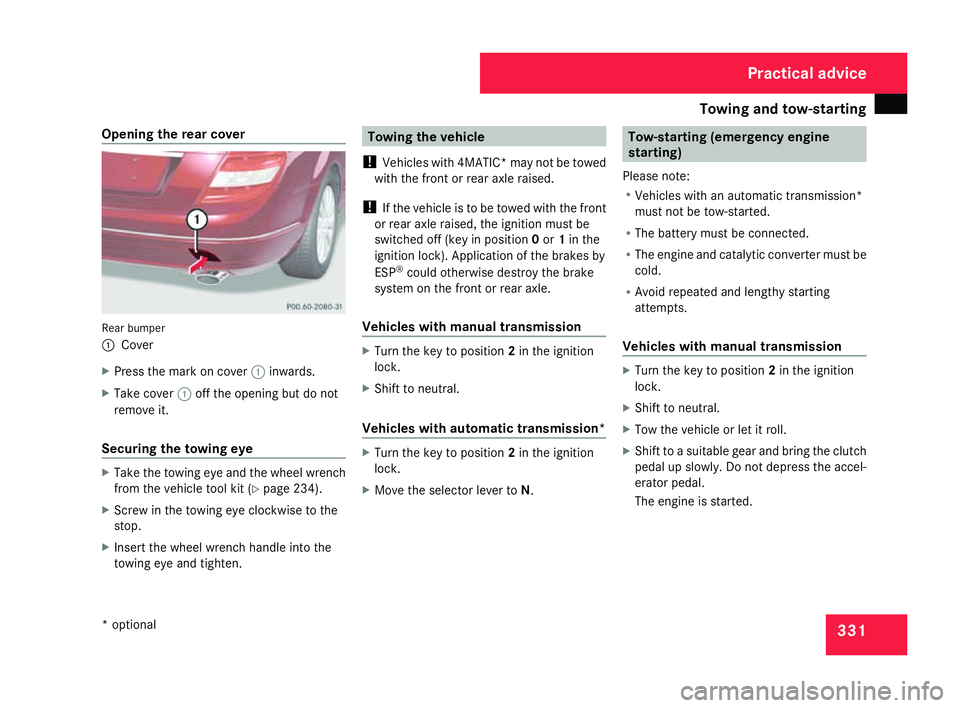
Towing and tow-startin
g 331
Opening the rear cover
Rear bumper
1
Cove r
X Press the mark on cover 1inwards.
X Take cover 1off the opening but do not
remove it.
Securing the towing eye X
Take the towing eye and the wheel wrench
from the vehicle tool kit (Y page 234).
X Screw in the towing eye clockwise to the
stop .
X Insert the wheel wrench handle into the
towing eye and tighten. Towing the vehicle
! Vehicles with 4MATIC* may not be towed
with the front or rear axle raised.
! If the vehicle is to be towed with the front
or rear axle raised, the ignition must be
switched off (key in position 0or 1in the
ignition lock). Application of the brakes by
ESP ®
could otherwise destroy the brake
system on the front or rear axle.
Vehicles with manual transmission X
Turn the key to position 2in the ignition
lock .
X Shift to neutral .
Vehicles with automatic transmission * X
Turn the key to position 2in the ignition
lock .
X Move the selector lever to N. Tow-starting (emergency engine
starting )
Please note:
R Vehicles with an automatic transmission*
must not be tow-started.
R The battery must be connected.
R The engine and catalytic converter must be
cold.
R Avoid repeated and lengthy starting
attempts .
Vehicles with manual transmission X
Turn the key to position 2in the ignition
lock .
X Shift to neutral .
X Tow the vehicle or let it roll.
X Shift to a suitable gear and bring the clutch
pedal up slowly. Do not depress the accel-
erator pedal.
The engine is started. Practical advice
* optiona l
204_AKB; 2; 3, en-GB
mkalafa,
2007-06-26T23:11:51+02:00 - Seite 331
Page 335 of 377
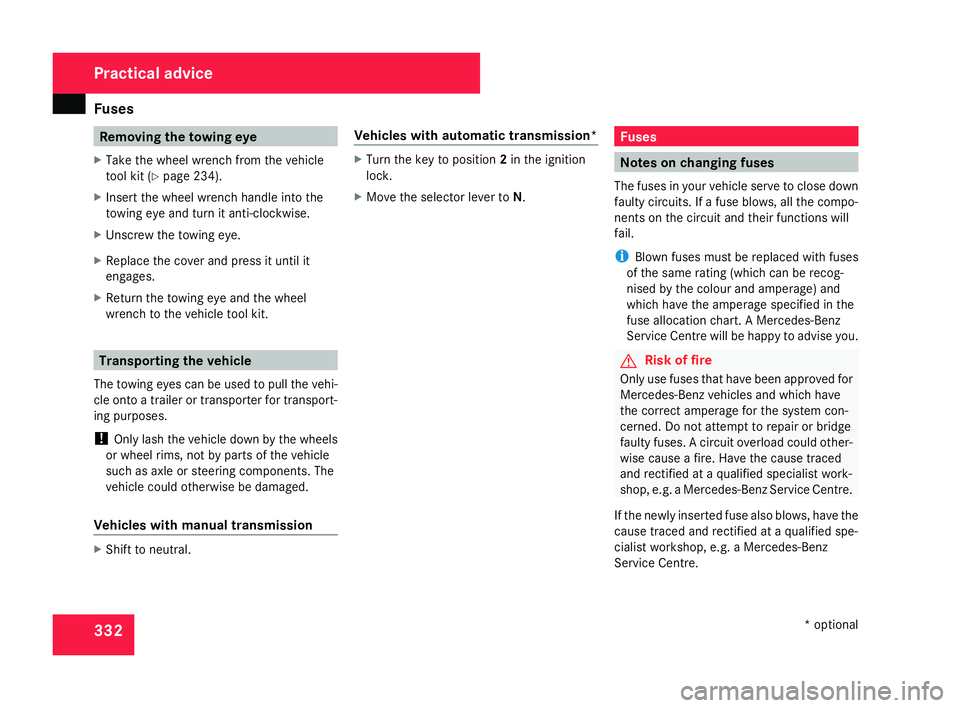
Fuse
s 332 Removing the towing eye
X Take the wheel wrench from the vehicle
tool kit (Y page 234).
X Insert the wheel wrench handle into the
towing eye and turn it anti-clockwise.
X Unscrew the towing eye.
X Replace the cover and press it until it
engages.
X Return the towing eye and the whee l
wrench to the vehicle tool kit .Transporting the vehicle
The towing eyes can be used to pull the vehi-
cle onto a trailer or transporter for transport-
ing purposes.
! Only lash the vehicle down by the wheels
or wheel rims, not by parts of the vehicl e
such as axle or steering components. The
vehicle could otherwise be damaged.
Vehicles with manual transmission X
Shift to neutral . Vehicles with automatic transmission
* X
Turn the key to position 2in the ignition
lock .
X Move the selector lever to N. Fuses
Notes on changing fuses
The fuses in your vehicle serve to close down
faulty circuits. If a fuse blows, all the compo -
nents on the circuit and their functions will
fail .
i Blown fuses must be replaced with fuses
of the same rating (which can be recog -
nised by the colour and amperage) and
which have the amperage specified in the
fuse allocation chart. A Mercedes-Benz
Service Centre will be happy to advise you. G
Risk of fire
Only use fuses that have been approved for
Mercedes-Benz vehicles and which have
the correct amperage for the system con-
cerned. Do not attempt to repair or bridge
faulty fuses. A circuit overload could other-
wise cause a fire. Have the cause trace d
and rectified at a qualified specialist work -
shop, e.g. a Mercedes-Benz Service Centre.
If the newly inserted fuse also blows, have the
cause traced and rectified at a qualified spe-
cialist workshop, e.g. a Mercedes-Benz
Service Centre. Practical advice
* optional
204_AKB; 2; 3, en-GB
mkalafa,
2007-06-26T23:11:51+02:00 - Seite 332
Page 342 of 377
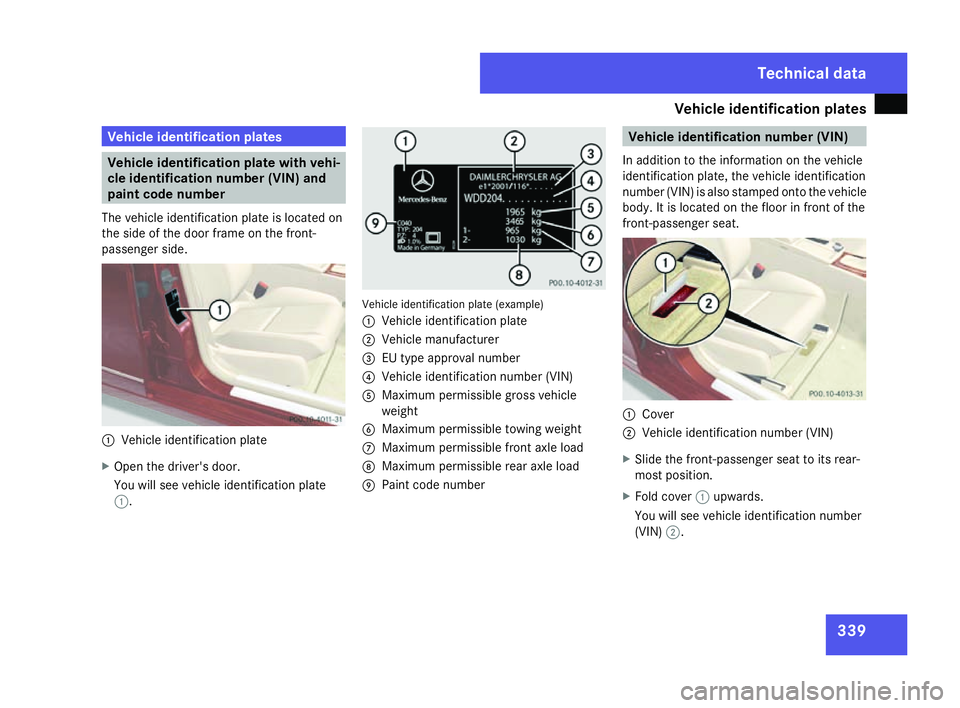
Vehicle identification plate
s 339Vehicle identification plates
Vehicle identification plate with vehi-
cle identification number (VIN) and
paint code number
The vehicle identification plate is located on
the side of the door frame on the front-
passenger side. 1
Vehicle identification plate
X Open the driver's door.
You will see vehicle identification plate
1 . Vehicle identification plate (example)
1
Vehicle identification plate
2 Vehicle manufacturer
3 EU type approval numbe r
4 Vehicle identification number (VIN)
5 Maximum permissible gross vehicle
weight
6 Maximum permissible towing weight
7 Maximum permissible front axle load
8 Maximum permissible rear axle load
9 Paint code number Vehicle identification number (VIN)
In addition to the information on the vehicle
identification plate, the vehicle identification
number (VIN) is also stamped onto the vehicle
body. It is located on the floor in front of the
front-passenger seat. 1
Cove r
2 Vehicle identification number (VIN)
X Slide the front-passenger seat to its rear-
most position.
X Fold cover 1upwards.
You will see vehicle identification number
(VIN) 2. Techni
cal data
204_AKB; 2; 3, en-GB
mkalafa
, 2007-06-26T23:11:51+02:00 - Seite 339
Page 359 of 377
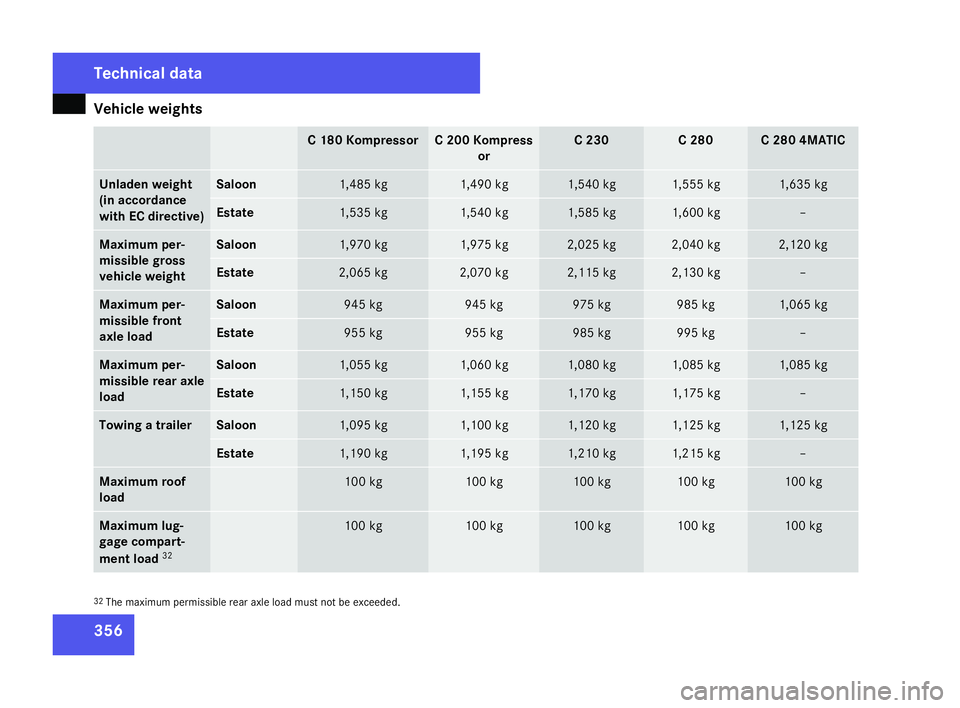
Vehicle weights
35
6 C 180 Kompressor C 200 Kompres
s
or C 230 C 280 C 280 4MATIC
Unladen weight
(in accordance
with EC directive) Saloon 1,485 kg 1,490 kg 1,540 kg 1,555 kg 1,635 kg
Estate 1,535 kg 1,540 kg 1,585 kg 1,600 kg –
Maximum per-
missible gross
vehicle weight Saloon 1,970 kg 1,975 kg 2,025 kg 2,040 kg 2,120 kg
Estate 2,065 kg 2,070 kg 2,115 kg 2,130 kg –
Maximum per-
missible front
axle load Saloon 945 kg 945 kg 975 kg 985 kg 1,065 kg
Estate 955 kg 955 kg 985 kg 995 kg –
Maximum per-
missible rear axle
load Saloon 1,055 kg 1,060 kg 1,080 kg 1,085 kg 1,085 kg
Estate 1,150 kg 1,155 kg 1,170 kg 1,175 kg –
Towing a trailer Saloo
n 1,095 kg 1,100 kg 1,120 kg 1,125 kg 1,125 kg
Estate 1,190 kg 1,195 kg 1,210 kg 1,215 kg –
Maximum roof
load 100 kg 100 kg 100 kg 100 kg 100 kg
Maximum lug-
gage compart
-
ment load 32 100 kg 100 kg 100 kg 100 kg 100 kg
32
The maximum permissible rear axle load must not be exceeded .Techni
cal data
204_AKB; 2; 3, en-GB
mkalafa
, 2007-06-26T23:11:51+02:00 - Seite 356
Page 360 of 377
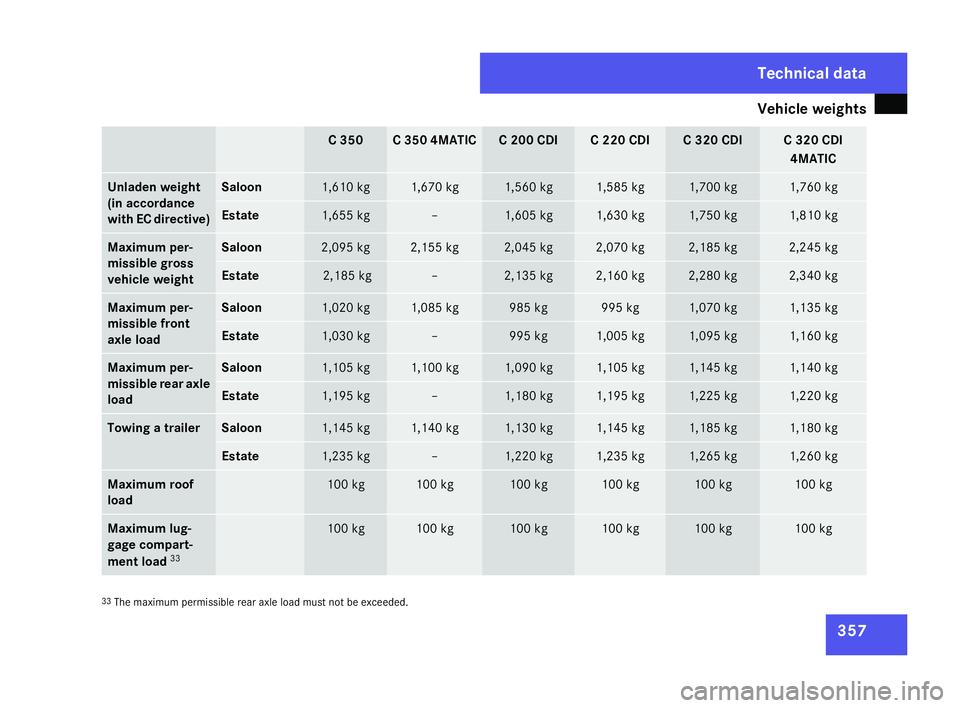
Vehicle weights
35
7 C 350 C 350 4MATIC C 200 CDI C 220 CDI C 320 CDI C 320 CDI
4MATIC Unladen weight
(in accordance
with EC directive) Saloon 1,610 kg 1,670 kg 1,560 kg 1,585 kg 1,700 kg 1,760 kg
Estat
e 1,655 kg – 1,605 kg 1,630 kg 1,750 kg 1,810 kg
Maximum per-
missible gross
vehicle weight Saloon 2,095 kg 2,155 kg 2,045 kg 2,070 kg 2,185 kg 2,245 kg
Estate 21
85 kg – 2,135 kg 2,160 kg 2,280 kg 2,340 kg
Maximum per-
missible front
axle load Saloon 1,020 kg 1,085 kg 985 kg 995 kg 1,070 kg 1,135 kg
Estate 1,030 kg – 995 kg 1,005 kg 1,095 kg 1,160 kg
Maximum per-
missible rear axle
load Saloon 1,105 kg 1,100 kg 1,090 kg 1,105 kg 1,145 kg 1,140 kg
Estate 1,195 kg – 1,180 kg 1,195 kg 1,225 kg 1,220 kg
Towing a trailer Saloon 1,145 kg 1,140 kg 1,130 kg 1,145 kg 1,185 kg 1,180 kg
Estate 1,23 kg – 1,220 kg 1,235 kg 1,265 kg 1,260 kg
Maximum roof
load 100 kg 100 kg 100 kg 100 kg 100 kg 100 kg
Maximum lug-
gage compart-
ment load
33 100 kg 100 kg 100 kg 100 kg 100 kg 100 kg
33
The maximum permissible rear axle load must not be exceeded. Technical data
204_AKB; 2; 3, en-GB
mkalafa,
2007-06-26T23:11:51+02:00 - Seite 357 5
,
Page 364 of 377
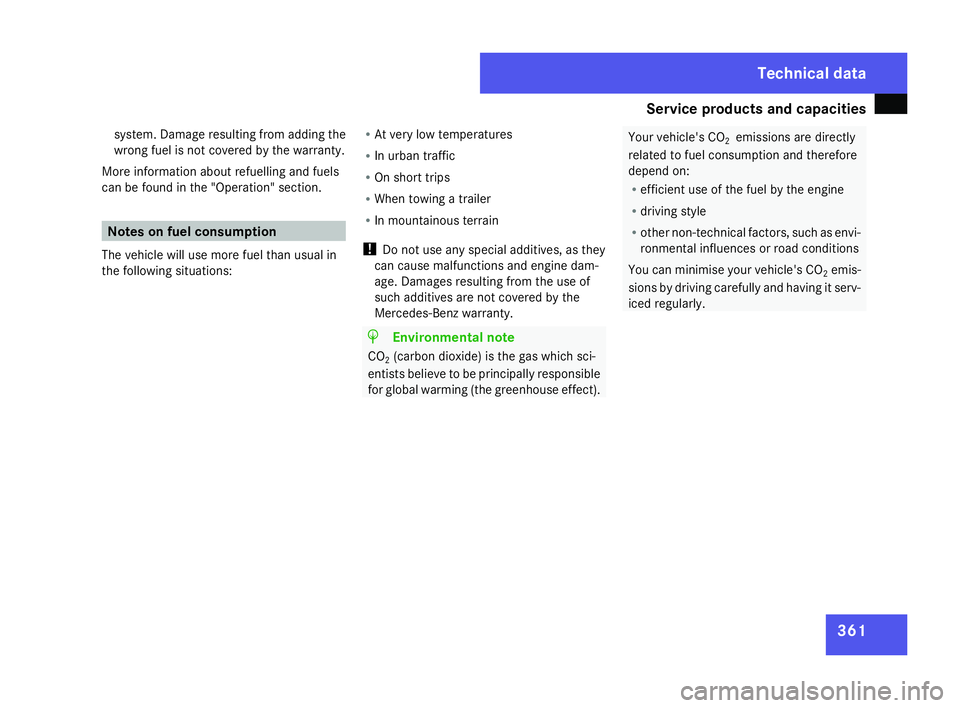
Service products and capacities
361
system. Damage resulting from adding the
wrong fuel is not covered by the warranty.
More information about refuelling and fuels
can be found in the "Operation" section. Notes on fuel consumption
The vehicle will use more fuel than usual in
the following situations: R
At very low temperatures
R In urban traffic
R On short trips
R When towing a trailer
R In mountainous terrain
! Do not use any special additives, as they
can cause malfunctions and engine dam-
age. Damages resulting from the use of
such additives are not covered by the
Mercedes-Benz warranty. H
Environmental not
e
CO 2(carbon dioxide) is the gas which sci-
entists believe to be principally responsible
for global warming (the greenhouse effect). Your vehicle's CO
2emissions are directly
related to fuel consumption and therefore
depend on:
R efficient use of the fuel by the engin e
R driving style
R other non-technical factors, such as envi-
ronmental influences or road conditions
You can minimise your vehicle's CO 2emis-
sions by driving carefully and having it serv-
iced regularly. Technical data
204_AKB; 2; 3, en-GB
mkalafa,
2007-06-26T23:11:51+02:00 - Seite 361